Notes Contemplating an Excursion from the Edge (of the Forest of Dean)
.jpg) On the fairly tenuous basis that the best Lyonaise potatoes I have ever eaten were in Lyon, I had this idea of visiting every single English county and trying out the local specialty.
On the fairly tenuous basis that the best Lyonaise potatoes I have ever eaten were in Lyon, I had this idea of visiting every single English county and trying out the local specialty.
Recently, on a particularly manic night, I compiled an itinerary that involved visiting every single county and eating something. At one time, I would have dropped everything and done just that. I didn’t, which proves that the medication is working.
However, I realized that I have had both food and drink in every English “shire” over the years and cooked a large number of regional dishes. So I made a list.
Some counties proved problematical. Nottinghamshire was never famous for its cuisine. It was known mainly for mining, bicycles and cigarettes. Thatcher did for mining, the bike factory shut and the smokers either died or gave up. However, the only time I have ever been physically removed from an eatery was in Nottingham.
I’m not sure they actually eat anything worth eating in Northamptonshire, but it did provide a most bizarre culinary experience: The Crisp Sandwich. I must also admit that my only visit to Huntingdonshire involved a very drunken afternoon at a race meeting, but I do remember eating something.
One thing I noticed was the amount of pork and pork products we eat in Britain. 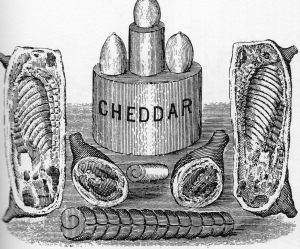 They are very versatile animals and they say that you can eat every part of the pig except the oink. Another thing we do well is cheese. I have deliberately picked out the two that I don’t like.
They are very versatile animals and they say that you can eat every part of the pig except the oink. Another thing we do well is cheese. I have deliberately picked out the two that I don’t like.
Every county (even Northamptonshire) produces good beer, mainly due to the microbreweries that have sprung up over recent years. I have restricted my comments to two large scale brewers: One good and one not so good.
The geographers will note that I am using the historic counties and boundaries. I could use the latest local government administrative areas, but who wants to eat a Greater Manchester Metropolitan District Hotpot?
Although London was a county for many years, it is not an historic county. Monmouthshire has been in both England and Wales. It is now with its rightful owners, the Welsh. Well here we go, from Bedfordshire to Yorkshire.
1. Bedfordshire: Bedfordshire Clanger
This is a suet pudding. I love suet puddings. My favourite is steak, kidney, oyster and Guinness. When you put a knife in it the steam comes out and you can’t see a thing if you wear glasses. The Bedfordshire Clanger is two dishes in one. Originally, the inside was filled with meat and the outside was studded with fruit. Remove the meaty inside and you end up with Spotted Dick (a sweet suet pudding, not a medical condition).
2. Berkshire: Eton Mess
Allegedly invented at Eton College, an exclusive and expensive private educational establishment where you have to dress funny and study arrogance and superiority. Eton provides most of the government when Labour isn’t in office. This dessert is a strange jumble of strawberries, meringue and cream. That is why it is called a mess. I prefer it without the meringue, but I suppose that misses the point.
3. Buckinghamshire: Aylesbury Duck
Aylesbury is the place where they bred an all-purpose white duck. They are pretty good at turning feed into meat and eggs. They used to march them the 40 odd miles to London, dipping their feet in tar to give them “shoes”. Make sure you buy a bird that is at least 4 lb and complete with giblets. The giblets make yummy gravy. Cook on a rack over a roasting dish. The fat from roasting can be used to make delicious roast potatoes.
4. Cambridgeshire: Fruit
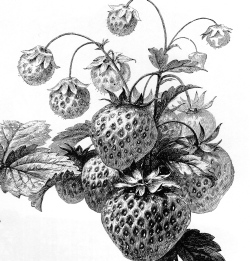 The Cambridge Favourite is a variety of strawberry that actually tastes like a strawberry. They are quite small and very sweet. The Cambridge Gage is a small plum and has a slightly sharp taste, but is excellent in pies and tarts. The Fenland area around Wisbech has plenty of farm shops and pick-your-own operations. I’m told that fruit Pick-your-owns factor in the fact that you will eat at least 50% of what you pick before you get to the pay-desk. To achieve maximum value, try and eat as much as possible before paying.
The Cambridge Favourite is a variety of strawberry that actually tastes like a strawberry. They are quite small and very sweet. The Cambridge Gage is a small plum and has a slightly sharp taste, but is excellent in pies and tarts. The Fenland area around Wisbech has plenty of farm shops and pick-your-own operations. I’m told that fruit Pick-your-owns factor in the fact that you will eat at least 50% of what you pick before you get to the pay-desk. To achieve maximum value, try and eat as much as possible before paying.
5. Cheshire: Cheshire Cheese
There may be an artisan cheese maker producing the real McCoy. But in my experience this is the blandest “real” cheese in Britain. Two types: coloured (orange) and white. Both taste the same: not very cheesy. Not as dreadfully nasty as Sage Derby. If you really want to have tasteless cheese, most supermarkets sell “low fat extra mild cheddar”. This is cheese for people who don’t like cheese.
6. Cornwall: Cornish Pasties
A proper pasty should be made of diced beef, swede [turnip to Americans], carrot and potato and short crust pastry and will be delicious. Similar pasties are also made in Devon, where they are known as Tiggy Oggies. Avoid the ones sold in petrol stations. They contain minced ingredients, preservatives and industrial puff pastry. They are actually made in Cornwall, but to that county’s eternal shame bear little resemblance to the real thing.
7. Cumberland: Cumberland Sauce
This is the stuff to go with cold meats or game pie; a thin sauce made with redcurrant jelly, orange and lemon zest and juice, port, mustard and ground ginger. It is always served cold. The sauce was named after the first Duke of Cumberland. He was the fifth son of one of our kings, almost certainly German and probably never set foot in Cumberland.
8. Derbyshire: Sage Derby Cheese
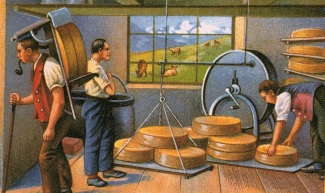 This is a cheese flavored with sage. It tastes strangely medicinal and is best avoided. Originally there was just plain Derby Cheese. It must have been truly awful to have required that sort of “improvement”. There are well over 300 cheeses made in England. In this tour, I have managed to locate the worst examples.
This is a cheese flavored with sage. It tastes strangely medicinal and is best avoided. Originally there was just plain Derby Cheese. It must have been truly awful to have required that sort of “improvement”. There are well over 300 cheeses made in England. In this tour, I have managed to locate the worst examples.
9. Devon: Cream Teas
Not for diabetics and contains lots of cholesterol, sugar and saturated fat. A sultana scone, butter, strawberry jam and clotted (boiled to thicken) cream, served with tea, mainly to tourists. At least it keeps cardiologists in regular work.
10. Dorset: Oysters
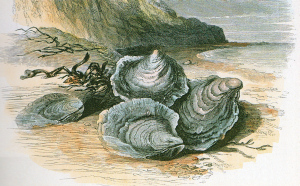 Abbotsbury Oysters is a collection of sheds by Chesil Beach, close to the seaside resort of Weymouth. They sell Natives and Atlantic, depending on the time of year. A dozen with a bottle of Stout is the perfect lunch. You get a choice of condiments, lemon, pepper, Tabasco sauce or marinade of shallots and white wine vinegar.
Abbotsbury Oysters is a collection of sheds by Chesil Beach, close to the seaside resort of Weymouth. They sell Natives and Atlantic, depending on the time of year. A dozen with a bottle of Stout is the perfect lunch. You get a choice of condiments, lemon, pepper, Tabasco sauce or marinade of shallots and white wine vinegar.
11. County Durham: Newcastle Brown Ale
Not made in Newcastle anymore, not really brown and not “real” ale. They recently moved the brewery to an industrial estate, miles away from Newcastle. It lost its “Protected Designation of Origin (PDO)” status. Quite right too, PDO was brought in to protect things like Champagne and Parmesan Cheese, not to protect a pretty inferior beer.
12. Essex: Tiptree Jams
Tiptree, in Essex, has a rather large jam factory. The firm that runs it also grows a lot of its own fruit. This is good stuff. I especially like their ginger preserve (Preserves are made from foreign stuff, conserves are made from English fruit) and the redcurrant jelly makes the perfect base for Cumberland Sauce. According to the website, it is available in the US.
13. Gloucestershire: Star Anise Café
Nick Allen runs an organic café in Stroud. Some of the produce is biodynamic, some produced by food co-ops, most of it locally grown locally. Frequented by poets, artists, ladies who lunch, green activists, people who do yoga and me. Mainly vegetarian, but they do a splendid twist on fish and chips on a Friday and kippers for Sunday brunch. Good food, excellent coffee and great for people watching.
14. Hampshire: Isle of Wight Garlic
The Isle of Wight was once part of Hampshire but gained county status in the sixties. At high tide it is the smallest county in England. When the tide goes out Rutland wins by a nose. Most of Britain’s garlic is grown there for some reason. They have an annual Garlic Festival, mainly to keep the tourists amused.
15. Herefordshire: Cider, Perry
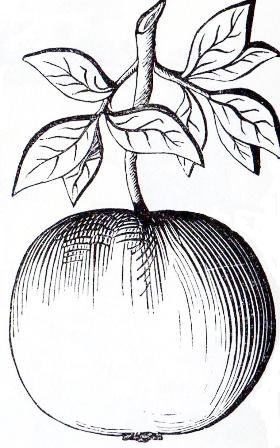 There is a big cider factory in Hereford. You can have guided tours. You may as well visit the Acme Chemical Company. There are still a few independent cider makers in the area and they are worth seeking out if you like that sort of thing. Perry is cider made from pears. I’ve never been a great lover of cider and I’ve seen regular cider drinkers getting into a right old state. Apparently, apple pips contain cyanide.
There is a big cider factory in Hereford. You can have guided tours. You may as well visit the Acme Chemical Company. There are still a few independent cider makers in the area and they are worth seeking out if you like that sort of thing. Perry is cider made from pears. I’ve never been a great lover of cider and I’ve seen regular cider drinkers getting into a right old state. Apparently, apple pips contain cyanide.
16. Hertfordshire: Shredded Wheat
I wrote a paragraph about Nabisco Welgar Shredded Wheat. Then I checked my facts. They used to be made by the National Biscuit Company (Nabisco) in Welwyn Garden City (Welgar). They were proud of their provenance. Alas, they have pulled the factory down. The brand has changed hands several times and the production has been transferred. I’ve stopped eating them for breakfast; they just aren’t the same anymore.
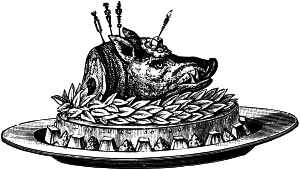 17. Huntingdonshire: Hog Roast
17. Huntingdonshire: Hog Roast
I once went to Huntingdon Races. I like country race meetings, especially in the winter when they race over fences for three or four miles. I nearly always eat the same thing: Hog Roast. They spit roast a whole pig. You get a large white bun filled with plenty of pork, crackling, stuffing and apple sauce. Simple, cheap and good. If I back a couple of winners, I’ll have two.
18. Kent: Dover Sole
A fish that is flat, white and delicious. Instructions for the perfect Dover Sole: Go to Dover, get ferry to France and buy several bottles of White Burgundy in Calais. Drive to Bolougne market and buy ingredients. Put ingredients in cool box with ice. Have lunch, wander around town, and return to England. Have sole for dinner. Grill and serve with the White Burgundy. If you insist, fresh green beans, small new potatoes and a Béarnaise sauce can be added.
19. Lancashire: Lancashire Hotpot
Lamb and lamb’s kidneys, onions, potatoes and stock topped with sliced potatoes. Uses neck, one of the cheapest cuts of lamb. For the best results, cook very slowly. Very similar to Irish Stew and the Welsh “caul”. Traditionally, the “stock” was plain old water. The dish can be improved with a stock cube and some herbs, but don’t tell the Lancastrians.
20. Leicestershire: Melton Mowbray Pies
Until recently, any old pork pie could be passed off as a Melton Mowbray. But a group of producers got together and applied for “Protected Designation of Origin” status. They were so successful that a major food company had to close a pie factory that just happened to be 120 miles away. Unlike most pork pies these use uncured pork so that the inside is grey rather than pink and they actually taste of pork.
21. Lincolnshire: Grimsby Fish
There used to be a sign on the way in to Grimsby that said “Grimsby, Home of the Haddock”. I thought they lived in the sea. Grimsby is the largest fishing port in England and houses several canners, freezers and processors. It had the largest fish finger factory in the world but it closed when the British discovered that fish had other bits you could eat, too.
22. Middlesex: Fullers Beer
The last remaining large scale brewery in the London area. They make ESB (Extra Special Bitter). It was the first proper pint I’d ever tried. My older and wiser drinking companion told me that it was an “acquired taste” and that I might not like it. It took me 20 seconds to acquire the taste and about 2 minutes to finish the pint. I liked it and still do. I understand that they export to the US. Try some.
23. Norfolk: Cromer Crab
 I’m quite partial to molluscs and marine gastropods, but my favorite shellfish is crustacean. Cromer, on the Norfolk coast, is a lovely little place where they land the sweetest, most delicious crabs. Buy the biggest one they have and eat it there and then, on the pier or beach looking out to sea. It does not need any accompaniments. It is perfection in itself.
I’m quite partial to molluscs and marine gastropods, but my favorite shellfish is crustacean. Cromer, on the Norfolk coast, is a lovely little place where they land the sweetest, most delicious crabs. Buy the biggest one they have and eat it there and then, on the pier or beach looking out to sea. It does not need any accompaniments. It is perfection in itself.
24. Northamptonshire: The Crisp Sandwich
I once went to Kettering Town football ground and made the mistake of being hungry at half-time. The only food available consisted of two slices of processed white bread, spread with margarine, surrounding half a packet of cheese and onion crisps. Evidently this was regarded as a delicacy. I doubt if things have improved much. Northamptonshire is a culinary disaster area. The game was rubbish too.
25. Northumberland: Caister Kippers
I do like a kipper. Caister Kippers are available in a rather posh chain of supermarkets where I regularly spend too much money. They are not dyed Day-Glo orange like the inferior varieties and they are properly smoked using traditional methods. The only drawback is that they stink the place out. The aroma of kipper hangs around for days.
26. Nottinghamshire: Refectory Food
I went after a very good job at an academic institution in Nottingham. I did the problem solving tests and passed the interview. Barring formalities, I’d got the job. The “formalities” consisted of a psychometric test designed to “ascertain my psychological profile”. I did the tests, handed them in and waited in the Refectory. Twenty minutes later, two security men came along and escorted me from the campus. I never heard from my potential employers again.
27. Oxfordshire: Banbury Cakes
A recipe was published in 1615 but the dish may be older, presumably dating from when we first started to trade with North Africa. They are made of puff pastry filled with “Banbury Meat”. This is a mixture of orange and lemon peel, currants, sugar, cinnamon, allspice, rosewater and butter. These would have been very exotic and expensive ingredients four hundred years ago. I managed to find all of them in my local supermarket.
28. Rutland: Trout
Rutland may be England’s smallest county (when the tide is out on the Isle of Wight) but it has Europe’s largest man-made lake. Rutland Water has some of the best Trout fishing going. The biggest one landed was a 15 lb monster. I thought a half-pounder was normally enough for dinner. You can fish quite cheaply, but you are supposed to throw them back. I don’t think I could bring myself to do that.
29. Shropshire: Ludlow Food Festival
Last year I went to the Ludlow Food Festival. It runs over a weekend early in September. They have a beer trail, where you can buy dozens of types of proper, English, beer. There is a sausage trail where you can buy and eat lots of different bangers. They have competitions to find the best produce. But the best bit is the tented village where hundreds of producers give away free samples. I spent the entire day stuffing my face. If you are malnourished, go to Ludlow in September.
30. Somerset: Bath Chaps
This is a pig’s cheek, rolled around part of the tongue, boiled like a ham and covered in breadcrumbs. It contains too much fat for my liking. Next time I find myself in possession of a pig’s head I will try my own version, using both cheeks, all of the tongue and with most of the fat removed. I shall call it “Tongue in Cheek”.
31. Staffordshire: Tamworth Pigs
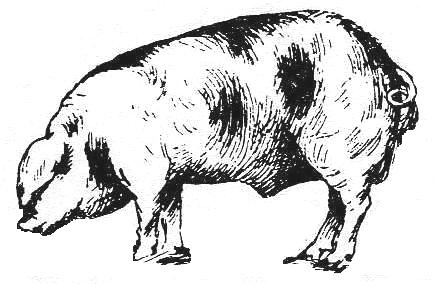 In 1998, two Tamworth rare-breed pigs escaped from an abattoir, went on the run and defied all attempts to catch them for a week. It turns out that they broke into a garden and the residents fed them and demanded guarantees that they would not to be turned into bacon. They ended up in an animal sanctuary; someone wrote a book and the BBC made a TV movie about them. You’ve read the book, seen the film, now eat the chops.
In 1998, two Tamworth rare-breed pigs escaped from an abattoir, went on the run and defied all attempts to catch them for a week. It turns out that they broke into a garden and the residents fed them and demanded guarantees that they would not to be turned into bacon. They ended up in an animal sanctuary; someone wrote a book and the BBC made a TV movie about them. You’ve read the book, seen the film, now eat the chops.
32. Suffolk: Newmarket Sausages
The Newmarket Sausage was a candidate for the valued Protected Designation of Origin status, but the two major producers, Musk’s and Powter’s, could not agree on a recipe. They contain a high proportion of shoulder meat and are in natural skins made from hog or sheep gut. Serve with mash and onion gravy.
33. Surrey: Pie & Mash
At one time, Surrey included most of south London and there were dozens of pie and mash shops. Pie and mash was the original cockney fast food. The pies are supposed to be meat and gravy. The pastry contains very little fat and goes rock hard if not eaten immediately. The pie and mashed potato is covered with “liquor” which is made from flour, water, salt and parsley. Very strange and it tastes better than it sounds.
34. Sussex: Brighton Rock
A stick of pink, peppermint flavored candy with the word “Brighton” (or the name of any other seaside resort) running all the way through it. I’ve been to the factory and it is fascinating. They make the letters about a foot high, wrap all the other stuff around it and roll it out into cylinders of various sizes. In the factory shop, I bought several sticks with obscenities replacing the word “Brighton”.
 35. Warwickshire: Birmingham’s Balti Belt
35. Warwickshire: Birmingham’s Balti Belt
A large population from the Indian sub-continent in the less salubrious suburbs of Birmingham has resulted in a proliferation of curry houses, take-away joints and Asian food shops. They are all trying to outdo and undercut each other, making it a great place to eat very cheaply and buy quality ingredients. 'Balti' means dish and some of these dishes are superb.
36. Westmoreland: Kendal Mint Cake
When I was a Boy Scout, I was told that this was essential for mountaineers. It is sugar and glucose flavored with mint. In fact it has exactly the same ingredients as Brighton Rock. Brighton Rock is frivolous and tastes nice. Mint Cake is serious and tastes horrible. When the British conquered Everest (actually, it was a New Zealander and a Nepalese who did most of the work, somehow we always took all of the credit) they took a bar or two up the mountain with them. They should have left it there.
37. Wiltshire: Lardy Cake
This is a cake made with yeast, sugar, currants, sultanas, sugar, flour, milk, salt, egg, mixed spice and, wait for it, lard. I tried it once and decided the taste wasn’t worth the potential damage. Lardy Cake is Wiltshire’s contribution to the national obesity problem. There are illegal drugs that will do you less harm.
38. Worcestershire: Evesham Asparagus
Wonderful. The best asparagus money can buy. Simmer for a couple of minutes. Let copious amounts of butter melt all over it. Grind some black pepper over it and enjoy. It will make your wee smell funny, but so what. If you want to be flash, replace the butter with Hollandaise sauce.
39. Yorkshire: Yorkshire Pudding
This dish is so simple that I have never managed to get it right. I was watching a TV shopping channel and they had a silicone baking set. The demonstrator showed that you could make perfect Yorkshire Pudding using this kit. Only twenty quid! Money-back guarantee! Next day delivery! While stocks last! I want it and I want it now. So I phoned the number. They had sold out. I was watching a repeat.
Having written the piece, I think I will visit every county. Not in a big manic rush, it will take time. The certainty is there will always be something nice to eat. This may involve more “Full English” breakfasts and fish and chips than is absolutely necessary.
The question is: How do I go about this gastronomic tour? I toyed with the idea of buying a tent. I even bought a second-hand directory of campsites. Then I realized that I am a bit arthritic and not seventeen anymore. I had visions of putting a tent up in the pouring rain. What a stupid idea. A camper van may be an option, but they are slow and expensive to run.
It will have to be “Bed & Breakfast”, preferably in a pub. The nearer counties can be covered by day trips. I will visit farms, factories and markets and may even do a bit of sea fishing. I will buy stuff and bring it home and cook it. I might even manage a half-decent Yorkshire Pudding and find a veritable hoard of delicacies in Northamptonshire. We live in hope.
Over the next year or so, I’ll let you know how I get on.
© 2009 Charlie Burling, Wotton-Under-Edge, Gloucestershire, UK.

